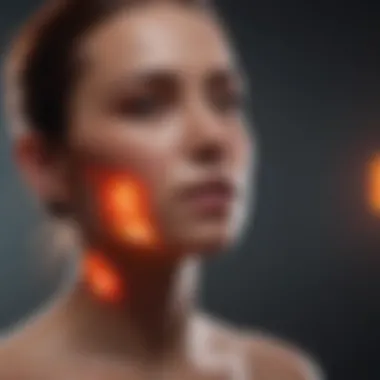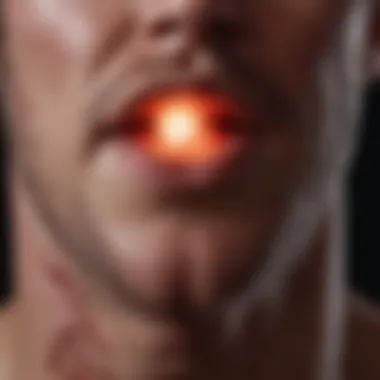Unlocking the Healing Potential: Red Light Therapy for Accelerated Wound Recovery


Research Overview
Red light therapy has emerged as a prominent treatment modality for wound healing due to its ability to promote tissue repair and reduce inflammation effectively. Also known as photobiomodulation, this therapy has garnered significant attention in the medical field. The scientific community has been actively studying its mechanisms of action and efficacy in wound management.
Health Implications
The application of red light therapy in wound healing holds significant implications for health outcomes. Studies have suggested that this therapy can enhance the natural healing processes of the body and expedite recovery from wounds. However, like any medical intervention, there may exist potential risks that need to be considered. It is crucial to explore both the benefits and risks associated with red light therapy to make informed decisions regarding its use in clinical practice.
Well-being Strategies
Incorporating red light therapy into wound management strategies can yield positive outcomes for overall well-being. By understanding the practical tips and strategies derived from research, individuals can actively participate in their healing journeys. Implementing these evidence-based recommendations can potentially enhance wound healing and improve quality of life. Real-life examples and case studies can shed light on the effectiveness of these strategies in a practical setting.
Expert Insights
Experts in the field provide valuable insights into the research findings surrounding red light therapy for wounds. Analyzing expert opinions can offer a deeper understanding of the implications of this therapy on clinical practice and patient outcomes. Conducting Q&A sessions with relevant experts can further clarify any queries and provide nuanced perspectives on the application of red light therapy in wound care.
Introduction to Red Light Therapy
Red light therapy, also referred to as photobiomodulation, holds a pivotal role in wound healing practices. Through harnessing the power of specific light wavelengths, this therapy has garnered significant attention for its profound impact on tissue repair and inflammation reduction. In the realm of wound management, the application of red light therapy showcases immense potential in expediting healing processes and improving overall outcomes. By shedding light on the foundational principles and practical advantages of red light therapy, this section aims to offer a nuanced understanding of its therapeutic significance.
Understanding Red Light Therapy
What is Red Light Therapy?
Red light therapy entails the utilization of low-level wavelengths to stimulate cellular activity and trigger natural healing responses within the body. This modality stands out for its non-invasive nature and targeted approach towards enhancing tissue repair mechanisms. The primary allure of red light therapy lies in its ability to penetrate deep into the skin, reaching the mitochondria and facilitating the production of adenosine triphosphate (ATP), essential for cellular function. This characteristic renders it a preferred choice in wound healing due to its capacity to accelerate regeneration processes effectively.
History of Red Light Therapy
Diving into the historical roots of red light therapy unveils a lineage of scientific exploration and medical innovation. tracing back to ancient civilizations that recognized the therapeutic properties of light. Over time, the evolution of technology and research has propelled red light therapy into mainstream healthcare, with a robust foundation of scientific evidence supporting its efficacy. The historical trajectory of red light therapy underscores its enduring relevance in modern wound management practices, standing as a testament to its enduring legacy and transformative potential.
Benefits of Red Light Therapy
The benefits of red light therapy are multifaceted, ranging from accelerated wound healing to reduced inflammation and pain management. One of the key advantages of this therapy is its versatility, as it can be utilized across various wound types and conditions. Moreover, red light therapy offers a safe and gentle alternative to traditional treatments, minimizing the risk of side effects and complications. By harnessing the beneficial properties of red light, individuals can embark on a journey towards enhanced recovery and revitalized tissue regeneration.
Mechanisms of Red Light Therapy
Cellular Impact of Red Light
The cellular impact of red light therapy revolves around its ability to stimulate mitochondrial function and promote cellular rejuvenation. By triggering photochemical reactions at the cellular level, red light therapy optimizes energy production and enhances metabolic processes. This, in turn, accelerates tissue repair and regeneration, making it a valuable asset in wound healing protocols. The nuanced cellular impact of red light therapy underscores its pivotal role in optimizing physiological functions and fostering holistic well-being.
Role in Mitochondrial Function


Red light therapy plays a crucial role in supporting mitochondrial function, a key player in cellular energy production. By bolstering mitochondrial activity, red light therapy enhances cellular resilience and fortifies the body's healing capabilities. This mechanism is particularly beneficial in the context of wound healing, where efficient mitochondrial function is imperative for optimum tissue repair. The synergistic relationship between red light therapy and mitochondrial function underscores their combined efficacy in promoting recovery and mitigating physiological imbalances.
Effects on Wound Healing
The profound effects of red light therapy on wound healing are exemplified through its capacity to expedite recovery, reduce inflammation, and minimize scarring. By modulating inflammatory processes and promoting tissue regeneration, red light therapy accelerates the healing cascade and improves overall wound outcomes. This therapeutic modality not only addresses the immediate symptoms of wounds but also addresses underlying cellular mechanisms, ensuring comprehensive and sustainable healing. The transformative effects of red light therapy on wound healing reflect its potency as a cutting-edge intervention in the realm of healthcare.
Science Behind Red Light Therapy
Red light therapy, also referred to as photobiomodulation, has become a focal point in wound healing due to its remarkable benefits in tissue repair and inflammation reduction. Understanding the science behind red light therapy is pivotal in comprehending its efficacy in managing wounds. The mechanisms through which red light therapy operates shed light on its transformative impact on cellular processes, making it a promising modality for enhancing wound healing outcomes. By exploring the intricate details of how red light therapy influences biological responses, we can uncover the rationale behind its growing popularity and widespread adoption.
Biological Responses to Red Light
Activation of Cellular Signaling Pathways
The activation of cellular signaling pathways is a cornerstone in the realm of red light therapy. This process involves the initiation of specific cellular mechanisms triggered by exposure to red light wavelengths. By elucidating the fundamental role of cellular signaling pathways in response to red light therapy, we can grasp its significance in regulating key functions at the cellular level. The unique characteristic of this activation lies in its ability to stimulate intricate pathways that orchestrate cellular repair and regeneration effectively. Understanding the advantages and potential limitations of this signaling activation provides valuable insights into the rationale for its incorporation into wound management protocols.
Stimulation of ATP Production
One of the pivotal responses elicited by red light therapy is the stimulation of adenosine triphosphate (ATP) production. This process involves the enhanced synthesis of ATP, the energy currency of cells, following exposure to red light. By highlighting the key characteristic of ATP production stimulation, we can appreciate its contribution to cellular metabolism and function. The unique feature of this stimulation lies in its capacity to fuel cellular activities essential for optimal tissue repair and regeneration. Discussing the advantages and considerations of ATP production stimulation in the context of wound healing underscores its relevance in harnessing the therapeutic potential of red light therapy.
Modulation of Inflammatory Processes
The modulation of inflammatory processes stands out as a critical aspect of red light therapy's biological responses. Through its anti-inflammatory effects, red light therapy acts to regulate and balance inflammatory pathways within the body. The key characteristic of this modulation lies in its ability to mitigate excessive inflammation while promoting a conducive environment for healing. By delving into the unique features of inflammatory process modulation, we can discern its advantages in promoting favorable wound healing outcomes. Understanding the implications and potential drawbacks of this modulation underscores its role in optimizing the therapeutic benefits of red light therapy for wounds.
Clinical Evidence and Studies
Research on Wound Healing
Efficacy in Tissue Regeneration
Comparison to Traditional Therapies
Continued in the next section
Application of Red Light Therapy for Wounds
Wound Types and Treatments
Chronic Wounds
Chronic wounds play a significant role in the field of wound management due to their persistent nature and challenges in healing. These types of wounds, which include pressure ulcers, diabetic ulcers, and venous ulcers, present a unique characteristic of slow healing and often require advanced treatment modalities. In the context of this article, chronic wounds offer valuable insights into the long-term benefits of red light therapy in addressing complex healing processes. Despite their propensity for complications, chronic wounds serve as a beneficial focus for highlighting the efficacy of red light therapy in promoting tissue repair and reducing inflammation.


Acute Injuries
Acute injuries, such as lacerations, abrasions, and burns, differ from chronic wounds in their sudden onset and generally shorter healing timeline. These types of injuries demand prompt and effective treatment to ensure optimal recovery and minimal scarring. In the context of this article, acute injuries showcase the versatile nature of red light therapy in accelerating wound healing and reducing the risk of infection. Exploring the application of red light therapy for acute injuries elucidates its benefits in enhancing the natural healing process, making it a popular choice for managing a variety of traumatic wounds.
Post-Surgical Healing
Post-surgical healing represents a critical phase in the overall treatment journey, where proper wound care is essential to minimize complications and promote rapid recovery. The unique aspect of post-surgical healing lies in the need for careful monitoring and adherence to specific protocols to prevent infections and ensure optimal wound closure. Within the scope of this article, post-surgical healing serves as a key focus to emphasize the importance of red light therapy in facilitating tissue regeneration and reducing post-operative inflammation. By addressing the challenges associated with surgical wounds, red light therapy emerges as a promising adjunctive treatment for improving overall healing outcomes.
Protocols and Parameters
Optimal Wavelengths and Doses
The selection of optimal wavelengths and doses in red light therapy plays a critical role in determining its therapeutic efficacy for wound healing. Specific wavelengths within the red and near-infrared spectrum have been identified to have profound effects on cellular functions, including increased ATP production and enhanced tissue repair. In the context of this article, exploring the significance of optimal wavelengths and doses highlights the precision required in delivering red light therapy for maximal benefits while minimizing potential risks. Understanding the unique features of different wavelengths and their dosages is crucial for tailoring treatment protocols to specific wound types and individual patient needs.
Treatment Duration and Frequency
The duration and frequency of red light therapy sessions are essential factors that influence treatment outcomes and patient adherence. Determining the appropriate treatment duration, which may vary based on the severity and chronicity of the wound, is paramount for achieving optimal results. Likewise, establishing a consistent treatment frequency aligns with the biological mechanisms of red light therapy and ensures sustained therapeutic effects. Within this article, discussing the nuances of treatment duration and frequency sheds light on the importance of adherence to prescribed protocols for maximizing the benefits of red light therapy in wound healing.
Safety Precautions
The implementation of safety precautions in red light therapy protocols is fundamental in safeguarding patient well-being and preventing adverse effects. Due diligence in considering safety measures, such as eye protection and proper device calibration, is crucial to mitigate potential risks associated with light exposure. In the context of this article, emphasizing the significance of safety precautions underscores the importance of ensuring treatment safety without compromising therapeutic efficacy. By addressing safety concerns and following established guidelines, red light therapy can be integrated safely into wound management practices with minimal risk to patients.
Benefits and Risks of Red Light Therapy
In the context of this article about Red Light Therapy for wound healing, understanding the benefits and risks plays a crucial role in elucidating the efficacy and considerations associated with this treatment modality. Red Light Therapy, also known as photobiomodulation, offers a non-invasive approach towards promoting tissue repair and reducing inflammation. One of the primary advantages of Red Light Therapy is its non-invasive nature, which underscores its appeal as a therapeutic option. This non-invasive characteristic allows for targeted treatment without causing harm or damage to surrounding tissues, making it a preferable choice for individuals seeking gentle yet effective interventions for wound management.
Enhanced healing response is another key benefit associated with Red Light Therapy. By stimulating cellular signaling pathways and boosting ATP production, this therapy accelerates the body's natural healing mechanisms, leading to faster recovery and improved tissue regeneration. The enhanced healing response offered by Red Light Therapy aligns with the ultimate goal of optimizing wound care and fostering optimal outcomes in the healing process.
Moreover, Red Light Therapy is known for its minimal side effects, making it a safe and well-tolerated option for individuals undergoing wound treatment. The minimal risk of adverse effects ensures that patients can benefit from this therapy without experiencing significant discomfort or complications, further solidifying its position as a viable and patient-friendly approach to wound healing.
Advantages of Red Light Therapy
Non-Invasive Nature
The non-invasive nature of Red Light Therapy distinguishes it as a gentle yet effective treatment modality that prioritizes patient comfort and safety. By utilizing low-level light wavelengths to penetrate the skin without causing any harm, this non-invasive approach ensures targeted delivery of therapeutic benefits to the affected area. The non-invasiveness of Red Light Therapy facilitates precise treatment without the need for surgical interventions, reducing the risk of complications and promoting a seamless healing process.
Enhanced Healing Response
The enhanced healing response elicited by Red Light Therapy arises from its ability to boost cellular metabolism and ATP synthesis, leading to accelerated tissue repair and regeneration. By triggering key cellular pathways involved in the healing process, this therapy optimizes the body's response to injury, resulting in faster recovery and improved outcomes. The enhanced healing response of Red Light Therapy underscores its efficacy in promoting efficient wound healing and enhancing overall tissue health.
Minimal Side Effects


With minimal side effects, Red Light Therapy stands out as a well-tolerated and safe treatment option for individuals seeking effective wound management strategies. The absence of significant adverse reactions ensures that patients can benefit from this therapy without experiencing unnecessary discomfort or complications. The minimal side effects associated with Red Light Therapy contribute to its reputation as a low-risk and patient-friendly approach to supporting wound healing efforts.
Potential Risks and Considerations
Overexposure Concerns
One potential risk associated with Red Light Therapy is the possibility of overexposure, which may lead to adverse effects such as skin irritation or burns. It is crucial to adhere to recommended dosages and exposure times to mitigate the risk of overexposure and ensure safe and effective treatment outcomes. By being mindful of exposure limits and following established guidelines, the risk of overexposure in Red Light Therapy can be effectively managed, enhancing its safety profile and optimizing treatment results.
Contradictions and Contraindications
While generally safe, Red Light Therapy may have contradictions and contraindications for certain individuals with specific medical conditions or sensitivities. It is essential to consult with a healthcare provider before initiating Red Light Therapy to assess any potential contradictions based on individual health considerations. By addressing contradictions and contraindications proactively, healthcare professionals can tailor treatment plans to meet the unique needs and safety requirements of each patient, ensuring optimal outcomes and preventing any adverse reactions.
Long-Term Effects
The long-term effects of Red Light Therapy on wound healing and tissue health require careful consideration to evaluate its sustained benefits and potential implications over time. While short-term results may demonstrate significant improvements in wound repair and inflammation reduction, assessing the long-term effects of repeated Red Light Therapy sessions is critical for understanding its lasting impact on tissue regeneration and overall healing outcomes. By monitoring patients' progress and conducting follow-up assessments, healthcare providers can gain insights into the enduring benefits of Red Light Therapy and make informed decisions regarding its continued use in wound management.
Future Directions and Conclusion
Red light therapy is an innovative approach in wound management that continues to show promise in enhancing healing processes. The topic of future directions is crucial as it sheds light on where the field of red light therapy for wounds is headed. Understanding the potential advancements and applications in this area can pave the way for more effective treatment strategies and improved patient outcomes. By exploring the evolving landscape of red light therapy, we can better grasp its expanding role in clinical settings and its implications for the future of healthcare practices.
Emerging Research Areas
Combination Therapies
Combination therapies represent an exciting frontier in red light therapy research. This approach involves integrating red light therapy with other treatment modalities to enhance therapeutic outcomes synergistically. The key characteristic of combination therapies lies in their ability to target multiple pathways involved in wound healing simultaneously, leading to accelerated tissue repair and reduced inflammation. Despite the advantages of combining therapies, it is essential to carefully consider the potential drawbacks, such as increased treatment complexity and potential side effects, to ensure optimal patient safety and efficacy in wound management.
Personalized Treatment Approaches
Personalized treatment approaches are gaining traction in the field of red light therapy for wounds. This tailored approach aims to customize treatment plans based on individual patient characteristics, such as the type and severity of the wound, underlying health conditions, and response to previous therapies. The unique feature of personalized treatment approaches lies in their ability to optimize treatment outcomes by addressing specific patient needs and tailoring interventions accordingly. While personalized approaches offer significant advantages in improving treatment efficacy and patient satisfaction, challenges such as resource allocation and scalability need to be carefully considered to ensure widespread adoption and effectiveness in clinical practice.
Integration into Healthcare Practices
The integration of red light therapy into mainstream healthcare practices marks a paradigm shift in wound management strategies. This integration involves incorporating red light therapy into existing treatment protocols across different healthcare settings to optimize patient care and outcomes. The key characteristic of integrating red light therapy lies in its potential to enhance treatment effectiveness, reduce healthcare costs, and improve patient satisfaction. However, challenges such as standardized protocols, staff training, and infrastructure requirements need to be addressed to facilitate seamless integration and ensure the successful implementation of red light therapy in healthcare practices.
Summary and Recommendations
Implications for Clinical Practice
The implications of incorporating red light therapy into clinical practice are significant in revolutionizing wound care approaches. By embracing red light therapy, healthcare providers can offer patients a non-invasive and effective treatment option for a wide range of wounds, promoting faster healing and minimizing complications. The key characteristic of this practice lies in its ability to complement traditional therapies and fill gaps in current treatment modalities, enhancing overall patient care and outcomes. While the advantages of incorporating red light therapy into clinical practice are evident, the need for further research, training, and awareness among healthcare professionals remains essential to maximize its benefits and ensure safe and effective implementation.
Guidelines for Optimal Use
Establishing clear guidelines for the optimal use of red light therapy in wound management is crucial for standardizing treatment protocols and promoting best practices. These guidelines outline recommended wavelengths and doses, treatment duration, frequency, and safety precautions to mitigate potential risks and optimize treatment outcomes. The unique feature of these guidelines lies in their ability to provide a framework for healthcare providers to deliver consistent and evidence-based care to patients undergoing red light therapy. While following these guidelines can enhance treatment efficacy and safety, ongoing updates and adherence to evolving research findings are necessary to ensure the continued quality and effectiveness of red light therapy in wound management.
Areas for Further Exploration
Exploring new frontiers and research avenues is essential for advancing the field of red light therapy for wounds. Areas for further exploration include investigating novel applications of red light therapy, optimizing treatment protocols through clinical trials, and identifying potential synergies with other emerging technologies. The key characteristic of exploring these areas lies in the potential to uncover innovative approaches, improve treatment outcomes, and expand our understanding of the underlying mechanisms of red light therapy. While the advantages of delving into these areas are vast, challenges such as funding, collaboration, and regulatory considerations need to be addressed to maximize the impact of future research efforts and propel the field of red light therapy forward.



